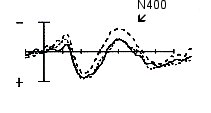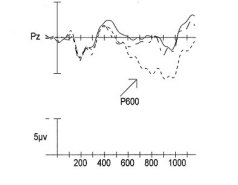Research Archive






|
 Form
and meaning Form
and meaning
The human brain
responds differently to anomalies involving sentence form
(syntax) and sentence meaning (semantics). Semantic
anomalies elicit an N400 effect in the ERP, and our lab was
the first to show that syntactic errors elicit a large
positive wave (the P600 effect).
Our past work has
shown that this result generalizes across anomaly type,
subjects' task, and languages. Here,
we show that this result also generalizes to situations in
which the anomalies are embedded in naturalistic prose. |
|
|
Morphological
decomposition
Non-words generally elicit a larger N400
component than do real words. We report
here that non-words made up of
real morphemes elicit a brain response very similar to that
elicited by real words. This result shows that word-like
stimuli are decomposed into their constituent morphemes. |
Secon d-language
word learning d-language
word learning
Although
second-language (L2) learning is often claimed to be slow
and difficult, little is known about the rate of
second-language word learning. We report
here that adult learners' brain
activity discriminated between L2 words and non-words after
just 14 hours of classroom L2 instruction. This
occurred even though the learners were at chance when
consciously deciding if the stimuli were words or not.
Apparently, some aspects of second-language learning occur
with amazing speed. We have extended this research to
studies investigating second-language syntactic learning.
|


 |

Meaning can "drive"
sentence comprehension Given that
separate syntactic and semantic processes exist, one
question is how we coordinate syntactic and semantic
knowledge when processing a sentence. The standard
theory holds that syntax alone determines how words are
initially combined to form phrases and clauses:
Syntactic structure is computed first, and sentence meaning
is derived second. Kim & Osterhout (in press) tested
this theory by presenting anomalous sentences such as "The
mysterious crime had been solving
...". The syntactic cues in the sentence require that
the noun crime be the Agent of the verb solving.
If syntax drives sentence processing, then the verb
solving would be perceived to be semantically
anomalous, as crime is a poor Agent for the verb
solve, and therefore should elicit an N400 effect.
However, although crime is a poor Agent, it is an excellent
Patient (as in solved the crime). The
Patient role can be accommodated simply by changing the
inflectional morpheme at the end of the verb ("The
mysterious crime had been solved . . .").
Therefore, if meaning drives sentence processing, then the
verb solving would be perceived to be in the wrong
syntactic form, and should therefore elicit a P600 effect.
We report that verbs like solving elicited a P600
effect, showing that a strong semantic attraction between a
predicate and an argument can determine how words are
combined, even when the semantic attraction contradicts
unambiguous syntactic cues. |
![]()